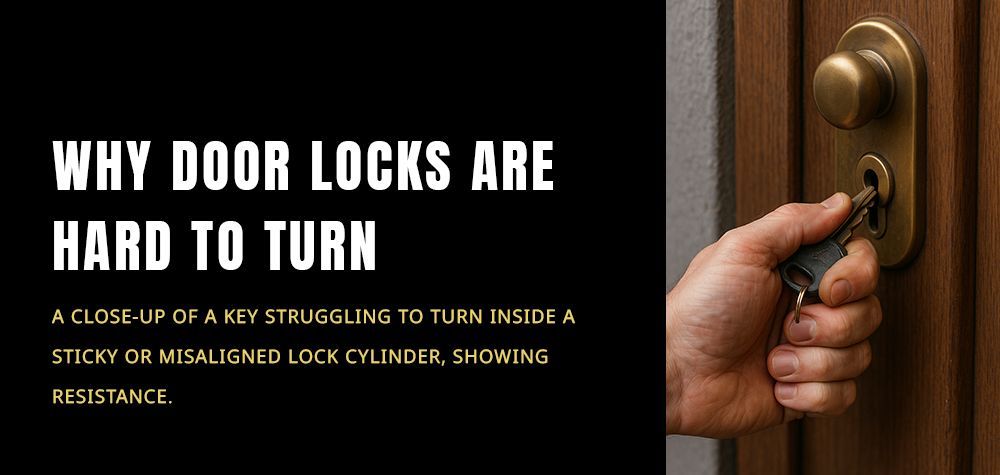Why Locks Malfunction After Storms and How to Prevent It
Storms can cause a lot of damage — broken windows, downed power lines, and flooded basements. But one problem many people don’t think about is how storms can affect your door locks. After heavy rain, high winds, or freezing temperatures, it’s not uncommon for a lock to jam, rust, or stop working altogether.
In this blog, we’ll explain why locks fail after a storm, the signs to watch for, and how you can protect your locks before and after bad weather.
How Weather Effects Your Locks?
How Storms Affect Your Locks
1. Moisture Gets Inside the Lock Mechanism
One of the biggest problems after a storm is water. Rainwater, snow, or humidity can get into the keyhole or inside the lock body. When this moisture sits for too long, it can cause rust, which makes the internal parts stick or break.
Locks on gates, sheds, garages, and exterior doors are most at risk.
2. Swollen or Warped Doors
After a storm, wooden doors may absorb moisture and swell. When the door frame expands, it can push against the lock, making it harder to turn the key or fully close the door. This puts pressure on the lock and can damage it over time.
3. Debris and Dirt Block the Lock
Windstorms often blow dust, sand, and dirt around. If debris gets inside the keyhole or the latch area, the lock can jam or become harder to use. Over time, this buildup can cause the lock to stop working entirely.
4. Power Loss Affects Smart Locks
If you use smart locks, a storm can knock out the power or your Wi-Fi. Without a backup battery or physical key option, you might be locked out. Even if the lock still works, it may not connect to your app or send notifications.
5. Extreme Cold Freezes the Lock
If a storm brings freezing temperatures, the moisture inside a lock can freeze solid. This makes it nearly impossible to turn the key or use a keypad. For homes in colder regions, frozen locks are a common post-storm issue.
Signs Your Lock Is Failing After a Storm
- The key is hard to insert or remove
- You need to jiggle the key to turn it
- The lock feels stiff or stuck
- The smart lock is not responding
- You hear grinding sounds when turning the key
- The door doesn’t shut or align with the frame properly
If you notice any of these signs after a storm, it’s best to take action right away before the lock breaks completely.
Best Locks for Summer Vacation Security in 2025
What to Do If Your Lock Is Already Stuck
- Don’t force the key. That can snap it inside the lock.
- Use a dry lubricant. Spray graphite or a lock-safe lubricant into the keyhole to loosen it.
- Check the door alignment. If the door is swollen, gently pull or push to relieve pressure.
- Call a locksmith. If the lock is rusty, jammed, or frozen, a professional can repair or replace it safely.
How to Prevent Lock Problems During Storm Season
1. Choose Weather-Resistant Locks
Not all locks are built to handle extreme weather. For outdoor use, pick locks labeled weatherproof, waterproof, or corrosion-resistant. Brands like Schlage, Kwikset, and Yale offer models made for tough environments.
2. Apply Lock Lubricant Regularly
Use a lock-specific lubricant (not WD-40) every few months to keep internal parts moving freely. This also helps repel moisture and dirt.
3. Install Door Sweeps and Seals
Weatherstripping around doors can reduce water entry and protect your lock and frame from moisture. It also keeps your door from swelling during heavy rain.
4. Use Lock Covers for Padlocks or Outdoor Locks
If you use padlocks on sheds, gates, or garages, cover them with a plastic or rubber cap to keep rain and snow out.
5. Keep Smart Lock Batteries Charged
For electronic locks, always keep the batteries fresh. Most smart locks will alert you when the battery is low, so don’t ignore the warning. Also, know how to unlock the door manually just in case.
6. Trim Nearby Trees and Gutters
Branches and clogged gutters can redirect water or debris toward your door. Keeping these areas clean helps protect both your door and the lock.
When to Replace the Lock After a Storm
Sometimes, repairs aren’t enough. You should consider replacing the lock if:
- The internal parts are rusted
- The lock turns but doesn’t latch
- The key constantly sticks or breaks
- The door frame is damaged
- You want better weather resistance moving forward
Replacing a lock before it completely fails can save you from a sudden lockout or a costly emergency repair.
Final Thoughts
Storms can do more than just cosmetic damage to your home — they can weaken your locks and compromise your security. Whether it’s moisture, debris, or freezing temperatures, your lock is vulnerable if not maintained.
To avoid trouble:
- Check your locks after every major storm
- Keep them clean and lubricated
- Invest in better locks for exposed areas
- Don’t wait too long to call a professional
Taking care of your locks now can save you a lot of stress later. After all, your front door is your home’s first line of defense — make sure it stays strong, even after the storm.
Call Us Any Time!







